I have a big timeseries dataset which looks like the table below. T0, T1, T2,... (goes on till T70) are the timestamps and over 400 batches (A,B,C,...). There are multiple features in the data (Description Column in the sample data) which I'm interested in plotting. My first attempt was to separate the dataset for each description so that I get one row per batch in each subset ranging from T0 to T70.
My aim is to convert this dataframe into a timeseries object and check for seasonality for Good and bad batches (for each description). Can someone help with any easy fixes in R? Thanks!
Update:
My subset of the data for one Description looks like this:

In order to melt the data, I used: mdf <- melt(df,id.vars = c('Batch',colnames(df[, c(2:70)]))) and it didn't work. I want to get just three variables out of it: Batch - Time - Value. Any help would be appreciated!
EDIT:dput(head(df,20)) gave the following output. I have truncated the output till T20 instead of T70.
structure(list(Batch = c("A", "B", "C",
"D", "E", "F", "G", "H",
"I", "J", "K", "L", "M",
"N", "O", "P", "Q", "R",
"S", "T"),
T0 = c(5, 6,
4, 2, 6, 3, 4, 6, 4, 1, 6, 5, 4, 5, 6, 5, 6, 5,
5, 6), T1 = c(6, 6, 6, 6, 6, 6, 6, 6, 6, 6, 6, 6,
6, 6, 6, 6, 6, 5, 6, 6), T2 = c(6, 6, 6, 6, 6, 6,
6, 6, 6, 6, 6, 6, 6, 6, 5, 6, 6, 6, 6, 6), T3 = c(20,
19, 19, 19, 19, 18, 20, 20, 20, 20, 20, 20, 20, 19,
18, 19, 20, 20, 20, 19), T4 = c(21, 21, 21, 21, 20,
20, 21, 21, 21, 21, 22, 21, 22, 21, 21, 21, 22, 21,
22, 20), T5 = c(22, 22, 22, 22, 22, 21, 21, 22, 21,
22, 23, 22, 23, 22, 22, 23, 23, 23, 23, 22), T6 = c(23,
23, 24, 23, 23, 23, 23, 23, 23, 24, 24, 23, 23, 24,
23, 24, 24, 24, 24, 23), T7 = c(25, 25, 25, 24, 24,
24, 24, 25, 25, 25, 24, 25, 24, 25, 25, 26, 25, 25,
25, 25), T8 = c(26, 26, 25, 26, 25, 26, 26, 26, 26,
26, 25, 26, 26, 26, 26, 26, 25, 26, 25, 26), T9 = c(20,
23, 19, 21, 22, 27, 24, 26, 24, 25, 21, 23, 21, 22,
28, 22, 20, 24, 19, 27), T10 = c(16, 18, 14, 15, 15,
23, 19, 20, 19, 20, 15, 16, 15, 17, 23, 16, 15, 18,
15, 23), T11 = c(15, 16, 15, 15, 16, 17, 15, 14, 15,
15, 15, 14, 15, 15, 17, 15, 15, 15, 15, 17), T12 = c(15,
16, 15, 15, 16, 14, 17, 15, 15, 15, 15, 15, 15, 16,
15, 15, 15, 16, 15, 15), T13 = c(15, 16, 15, 15, 16,
15, 15, 15, 15, 15, 15, 15, 15, 16, 15, 15, 15, 16,
14, 15), T14 = c(16, 16, 15, 16, 16, 15, 16, 15, 16,
15, 15, 15, 15, 16, 16, 15, 16, 16, 15, 16), T15 = c(16,
16, 16, 16, 17, 15, 16, 15, 16, 15, 16, 15, 16, 16,
16, 16, 16, 16, 15, 16), T16 = c(16, 17, 16, 16, 17,
15, 17, 15, 16, 16, 16, 16, 16, 16, 16, 16, 16, 16,
15, 16), T17 = c(17, 19, 17, 18, 20, 15, 18, 15, 16,
16, 18, 16, 18, 19, 19, 17, 19, 17, 17, 17), T18 = c(24,
26, 27, 26, 28, 22, 25, 20, 25, 20, 26, 25, 27, 26,
25, 25, 28, 25, 27, 24), T19 = c(36, 37, 36, 38, 36,
38, 37, 31, 36, 26, 36, 37, 36, 36, 37, 36, 37, 35,
35, 35), T20 = c(38, 39, 37, 38, 38, 43, 39, 41, 39,
40, 38, 39, 38, 39, 43, 38, 37, 39, 37, 42)), row.names = c(NA,
20L), class = "data.frame")



